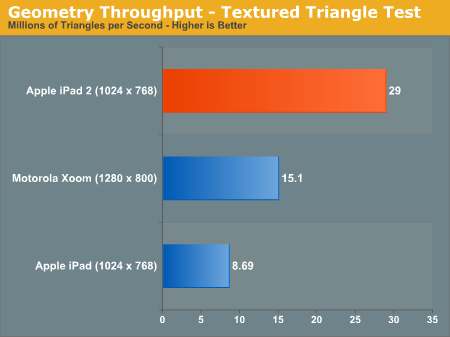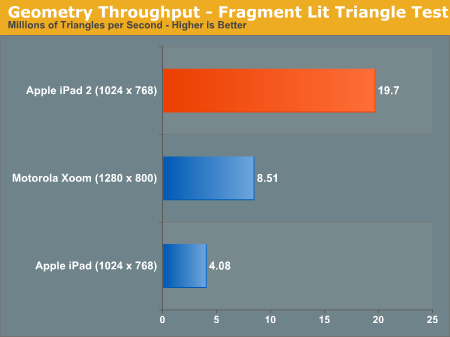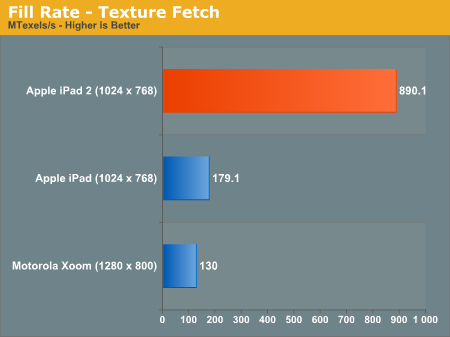Apple iPad 2 GPU Performance Explored: PowerVR SGX543MP2 Benchmarked
by Anand Lal Shimpi on March 12, 2011 3:04 PM EST- Posted in
- Smartphones
- Apple
- iPad
- GLBenchmark
- iPad 2
- Mobile
- Tablets
Earlier this morning we published our first impressions on Apple's iPad 2, including analysis on camera quality and a dive into the architecture behind Apple's A5 SoC. Our SoC investigation mostly focused on CPU performance, which we found to be a healthy 50% faster than the A4 in the original iPad - at least in web browsing. We were able to exceed Apple's claim of up to 2x performance increase in some synthetic tests, but even a 50% increase in javascript and web page loading performance isn't anything to be upset about. We briefly touched on the GPU: Imagination Technologies' PowerVR SGX 543MP2. Here Apple is promising up to a 9x increase in performance, but it's something we wanted to investigate.
Architecturally the 543MP2 has more than twice the compute horsepower of the SGX 535 used in Apple's A4. Each shader pipeline can execute twice the number of instructions per clock as the SGX 535, and then there are four times as many pipes in an SGX 543MP2 as there are in a 535. There are also efficiency improvements as well. Hidden surface removal works at twice the rate in the 543MP2 as it did in the 535. There's also a big boost in texture filtering performance as you'll see below.
As always we turn to GLBenchmark 2.0, a benchmark crafted by a bunch of developers who either have or had experience doing development work for some of the big dev houses in the industry. We'll start with some of the synthetics.
Over the course of PC gaming evolution we noticed a significant increase in geometry complexity. We'll likely see a similar evolution with games in the ultra mobile space, and as a result this next round of ultra mobile GPUs will seriously ramp up geometry performance.
Here we look at two different geometry tests amounting to the (almost) best and worst case triangle throughput measured by GLBenchmark 2.0. First we have the best case scenario - a textured triangle:

The original iPad could manage 8.7 million triangles per second in this test. The iPad 2? 29 million. An increase of over 3x. Developers with existing titles on the iPad could conceivably triple geometry complexity with no impact on performance on the iPad 2.
Now for the more complex case - a fragment lit triangle test:

The performance gap widens. While the PowerVR SGX 535 in the A4 could barely break 4 million triangles per second in this test, the PowerVR SGX 543MP2 in the A5 manages just under 20 million. There's just no competition here.
I mentioned an improvement in texturing performance earlier. The GLBenchmark texture fetch test puts numbers to that statement:

We're talking about nearly a 5x increase in texture fetch performance. This has to be due to more than an increase in the amount of texturing hardware. An improvement in throughput? Increase in memory bandwidth? It's tough to say without knowing more at this point.
| Apple iPad vs. iPad 2 | ||||
| Apple iPad (PowerVR SGX 535) | Apple iPad 2 (PowerVR SGX 543MP2) | |||
| Array test - uniform array access |
3412.4 kVertex/s
|
3864.0 kVertex/s
|
||
| Branching test - balanced |
2002.2 kShaders/s
|
11412.4 kShaders/s
|
||
| Branching test - fragment weighted |
5784.3 kFragments/s
|
22402.6kFragments/s
|
||
| Branching test - vertex weighted |
3905.9 kVertex/s
|
3870.6 kVertex/s
|
||
| Common test - balanced |
1025.3 kShaders/s
|
4092.5 kShaders/s
|
||
| Common test - fragment weighted |
1603.7 kFragments/s
|
3708.2 kFragments/s
|
||
| Common test - vertex weighted |
1516.6 kVertex/s
|
3714.0 kVertex/s
|
||
| Geometric test - balanced |
1276.2 kShaders/s
|
6238.4 kShaders/s
|
||
| Geometric test - fragment weighted |
2000.6 kFragments/s
|
6382.0 kFragments/s
|
||
| Geometric test - vertex weighted |
1921.5 kVertex/s
|
3780.9 kVertex/s
|
||
| Exponential test - balanced |
2013.2 kShaders/s
|
11758.0 kShaders/s
|
||
| Exponential test - fragment weighted |
3632.3 kFragments/s
|
11151.8 kFragments/s
|
||
| Exponential test - vertex weighted |
3118.1 kVertex/s
|
3634.1 kVertex/s
|
||
| Fill test - texture fetch |
179116.2 kTexels/s
|
890077.6 kTexels/s
|
||
| For loop test - balanced |
1295.1 kShaders/s
|
3719.1 kShaders/s
|
||
| For loop test - fragment weighted |
1777.3 kFragments/s
|
6182.8 kFragments/s
|
||
| For loop test - vertex weighted |
1418.3 kVertex/s
|
3813.5 kVertex/s
|
||
| Triangle test - textured |
8691.5 kTriangles/s
|
29019.9 kTriangles/s
|
||
| Triangle test - textured, fragment lit |
4084.9 kTriangles/s
|
19695.8 kTriangles/s
|
||
| Triangle test - textured, vertex lit |
6912.4 kTriangles/s
|
20907.1 kTriangles/s
|
||
| Triangle test - white |
9621.7 kTriangles/s
|
29771.1 kTriangles/s
|
||
| Trigonometric test - balanced |
1292.6 kShaders/s
|
3249.9 kShaders/s
|
||
| Trigonometric test - fragment weighted |
1103.9 kFragments/s
|
3502.5 kFragments/s
|
||
| Trigonometric test - vertex weighted |
1018.8 kVertex/s
|
3091.7 kVertex/s
|
||
| Swapbuffer Speed |
600
|
599
|
||
Enough with the synthetics - how much of an improvement does all of this yield in the actual GLBenchmark 2.0 game tests? Oh it's big.











219 Comments
View All Comments
mech0r - Friday, March 18, 2011 - link
"I suspect that number is still wildly inflated and falling fast."Wtf are you Steve Jobs himself? Or did you just say that cuz stevie told you that?
why do you "suspect" and not go "research" before repeating mindlessly what your cult leader tells you
tipoo - Saturday, March 12, 2011 - link
Possibly 3G/non 3G, and first generation being tested again too.BrooksT - Saturday, March 12, 2011 - link
What do you want? The iPad is >80% market share in a market Apple created. iPad 2 is kind of a big release.Do you think Anand or elsewhere should ignore market share, history, and user interest when deciding amount of coverage? Does avoiding "favoritism" mean giving equal amounts of coverage to Intel and Via CPUs?
Anand Lal Shimpi - Saturday, March 12, 2011 - link
There are three different models that we're testing (AT&T, Verizon and WiFi) and we've got a second WiFi that we borrowed so we can speed up battery life testing. Apple doesn't actually sample us most of the time and all Apple review samples go back after ~30 days (and we never accept money for reviews so that's out of the discussion as well). Because we don't get sampled, we have to do a lot of parallel testing in order to still deliver timely reviews. Not to mention that given the baseband issues we've seen in the past with Apple and other recently released smartphones, we want to have as many datapoints as possible to make sure we discover any issues that may exist.The PowerVR SGX 543MP2 is a particularly interesting GPU. It's something we'll see variants of in other SoCs going forward. We would've shown the same excitement and rush to test for any other platform that it debuted on.
As far as the pictures go. We have different folks do the photos for each article. Some products are easier to photograph in a way that looks cooler. I'd argue that the Atrix and Nexus S shots are just as good as what we've published here.
Take care,
Anand
chrnochime - Saturday, March 12, 2011 - link
Anand,Do you know or could you tell us which other tablet that's coming up in 2011 would sport a variant of the SGX 543MP2(or 4)? Now that your test shows the GPU is actually substantially quicker than the Tegra2, I would want to wait for some other tablet that sports a larger resolution.
Thanks.
metafor - Monday, March 14, 2011 - link
To date, I don't believe any have been announced. IIRC, TI is the only other SoC manufacturer with the 543MP in their roadmap and that won't be until the OMAP5 series next year.But that doesn't necessarily mean no one will catch up to the iPad 2 in GPU performance. Many manufacturers (Samsung, ST) are using ARM's Mali core, which if scaled up could be competitive. nVidia has their next-generation Geforce ULP coming in Tegra 3 and Qualcomm has their Adreno 220 later this year, so there are plenty of players.
KoolAidMan1 - Saturday, March 12, 2011 - link
Get over yourself.The iPad sold 15 million units in a year and the iPad 2 will likely double that. No other tablet will come anywhere close to that. It is obvious why Anand is covering that device.
It is also funny that you refer to the iPad 2 as "junk" when it is superior to the Xoom and every other tablet out there in terms of hardware, physical form factor, and application selection.
winterspan - Saturday, March 12, 2011 - link
How is this a hard concept to grasp? It has nothing to do with Apple paying anyone anything. The fact of the matter is that the iPad has and the iPad2 will sell tens of millions of units, far more than all the android tablets put together so far.It's a pretty simple business case:
1) $$$ = number of eyeballs looking at website articles (and hence advertising banners)
2) number of eyeballs = popularity of each article x number of articles
3) popularity of articles = popularity of article topic (product being previewed/reviewed)
4) iPad popularity > individual Android tablet popularity
5) iPad content popularity > other tablet content popularity
6) iPad content revenue > other tablet content revenue
EarthCore - Sunday, March 13, 2011 - link
Hmm, I'd say it's either favoritism or incompetence Anandtech? Which excuse are you going to choose? Why?Well, here goes a few things I noticed off the bat.
I grabbed the GL benchmark app, and here a few indicators that it needs to be re-worked for the Xoom:
The Xoom has 27 native Open GL extensions (MOTODEV > Products > XOOM™ MZ600)
the GL Benchmark app only found 21 (GLBenchmark Result Details of Motorola Xoom)
So off the bat with the app not using all available OpenGL extensions for honeycomb or for the Nvidia platform I'd say that it's "off."
Secondly, the app even incorrectly reads the screen size at 1280 x 752.
So right now I say these needs to be updated before I got too crazy with the results.
I didn't do a cross reference of the utilized libs over the ones "left on the table" but if I get a few minutes I will. But, if these guys at Anandtech are supposed to be "pros" at this, why the glaring omission?
I would like to see Engadget...oops, I mean Anandtech, update this article to reflect this and redo these tests when the playing field is balanced.
kmmatney - Sunday, March 13, 2011 - link
Get over yourself. Motorola Xoom is actually rendering at 1280x752, since the System Bar in Honeycomb is always taking up screen space.